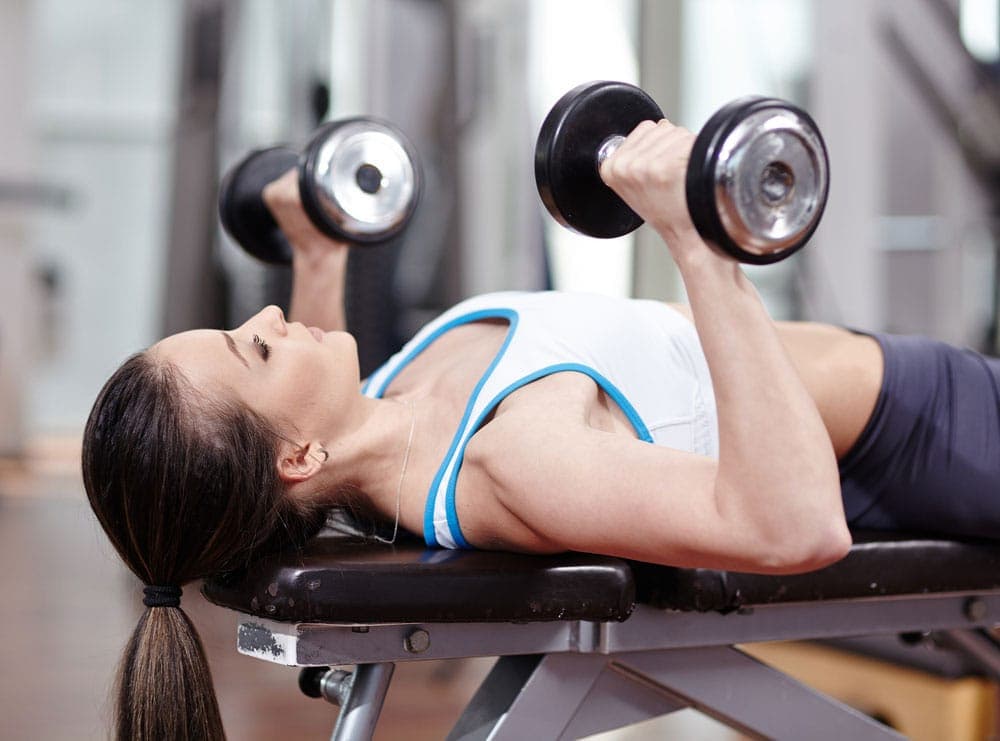The 6 Best Chest Workouts With Dumbbells
This guide will help you get to know the best chest workouts with dumbbells. Find out how to build your chest muscles.
For many weightlifters, even those with years of experience in the gym, the chest can be a stubborn muscle to grow. It seems like you push and push, and you may be benching a lot to no avail. Could you be doing it all wrong? It’s probably not an all-or-nothing problem, but if your growth seems to be stagnating, don’t worry; you’re not alone. Chest workouts with dumbbells can help!
There are several simple chest exercises that you can execute to grow a bigger chest. And these all use simple equipment for a no-stress chest day.
Here’s a roundup of the best chest workouts with dumbbells.
What Are the Benefits of Training Your Chest?
You’ll get bigger and build a body from these aesthetic workouts that has you looking great shirtless, duh. Well, yes, but that’s not the only benefit.
Take a look at a few other things that can happen when you start seriously focusing on training your chest.
Muscle Mass
Chest exercises like bench presses, push-ups, and flyes stimulate the major muscles of your chest (explained down below).
By putting these muscles under muscular stress, you help them grow. Muscle growth, aka hypertrophy, can lead to a bigger and more defined chest.
Here, you can get to know more about helping your muscles grow: Maximizing Muscle Hypertrophy.
Upper Body Strength
Not only will training chest help you look big, but you’ll probably notice a strength increase too. Strengthening your chest muscles can improve your overall upper body strength. Since all the parts of your body work synergistically and interact with one another, you could even notice more strength in your shoulders, arms, core, or any other muscles that assist chest exercises.
Better Athleticism
If you play a sport, a strong chest can help you excel at several performance-based skills. When we throw, punch, swing equipment, or push, we use the chest muscles. Training your chest lets you develop more power and even speed, and explosiveness in sport-specific skills.
Posture
Building your chest up can help you balance out the back body for better posture. If you’re crushing both chest day and back day regularly (or push and pull day, depending on how you train), you’ve probably built some solid muscle on the front and back of your trunk.
A strong chest acts as a counterbalance to the upper back muscles. Strengthening both areas will help both sides of your body to work together to help straighten out poor posture. You can say goodbye to hunched-over shoulders and a jutting neck and head, which we usually associate with weak chest muscles and posture issues.
Balanced Physique
Well-developed chest muscles help keep your body balanced and symmetrical. If you train for aesthetics, this is one of the best areas to train to keep your body looking proportionate.
Functional Movement
A strong chest lets you do the little things better. Performing everyday activities involving pushing or lifting motions, like carrying groceries, pushing the door open, or lifting your bags will feel like a breeze.
Lower Injury Risk
Stronger chest muscles may help you stabilize your shoulders and lower your risk of shoulder injuries. If you’re athletic, this could be extra beneficial, especially if you play a sport that involves lots of overhead pressing or throwing activities.
Metabolic Benefits
Don’t think it’s just running that leads to fat loss. If you’re cranking out chest exercises at high reps, you can burn some serious calories here too.
Although we don’t typically associate compound chest exercises, like bench presses, with cardio work, anything performed at a reasonable pace and at high reps will force you to enter the cardio zone.
Chest workouts with dumbbells where you work up a sweat can lead to more calorie burn during workouts and benefit your metabolic age and health over time.
More Confidence
And okay, you’ll probably look great too.
Overall, training your chest muscles gives you a wide range of benefits. From strength and athleticism to simply looking better, there’s sure to be a component of chest training that aligns with your goals in the gym.
Chest Muscles and Anatomy
So what do we mean by “training chest?”
When you do chest workouts with dumbbells, there are several muscles that activate to help you get your weights up. The primary muscles involved in chest exercises include:
Pectoralis Major
This is your largest chest muscle. The pectoralis major is responsible for most of your chest's size and shape. We also call the pectoralis major muscles the “pecs.” Technically this muscle has two heads: the clavicular head (upper chest) and the sternal head (lower chest).
Your pecs help you horizontally adduct the arm, meaning it helps bring the arm toward the center line of your body.
Pectoralis Minor
Located underneath the pectoralis major, your pectoralis minor helps move your shoulders. It’s especially helpful in movements where you’re lowering the shoulder blades (aka “scapulae”).
Anterior Deltoid
Your deltoids (“delts”) are technically shoulder muscles, but they’ll assist you in pretty much any move you do for your chest. The front portion of the deltoid muscle helps with shoulder flexion. When you push or press in a chest exercise, you’re using your delts.
Triceps
The triceps brachii, sit on the backs of your upper arms. They help you extend your elbows during pressing movements like bench presses or push-ups.
Serratus Anterior
This muscle sits on the side of the chest just under the armpit. The serratus anterior helps you stabilize your shoulder blades and assists with moves where you’re bringing your arms away from your body.
Best Chest Workouts With Dumbbells
Using dumbbells for chest workouts lets you switch it up from a typical barbell bench press or other moves that feel overused.
They offer you more versatility, yet you can still effectively target several areas of the chest for growth and major gains. Here are the top 6 best chest exercises with dumbbells:
1. Dumbbell Bench Press
- Set-Up: Lie on a flat bench with a dumbbell in each hand. Your weight should feel comfortable but challenging. Face your palms forward.
- Lift: Press your dumbbells straight up into the air until your arms are fully extended.
- Reverse: Hold for a pause, then lower your weights back down until your elbows comes to a 90-degree angle. Keep your back flat and core engaged as you lift.
- Reps: Try for 3 sets of 10-12 reps.
2. Dumbbell Flyes
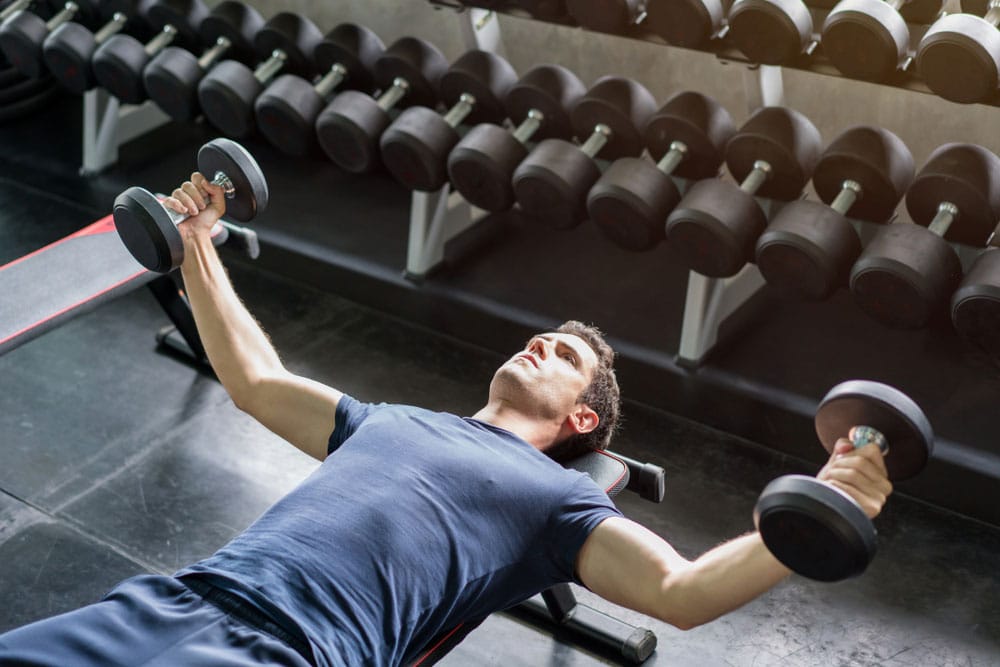
- Set-Up: Lie on a flat weight bench with a dumbbell in each hand. Face your palms inward so they’re turned towards each other.
- Lift: Extend your arms straight up over your chest, slightly bending your elbows. This will be your starting position.
- Reverse: Lower the dumbbells out to the sides making an arc shape until you feel your chest stretching and engaging. At this point, bring your arms back together over your chest with control.
- Reps: Try 3 sets of 10-12 reps.
3. Incline Dumbbell Press
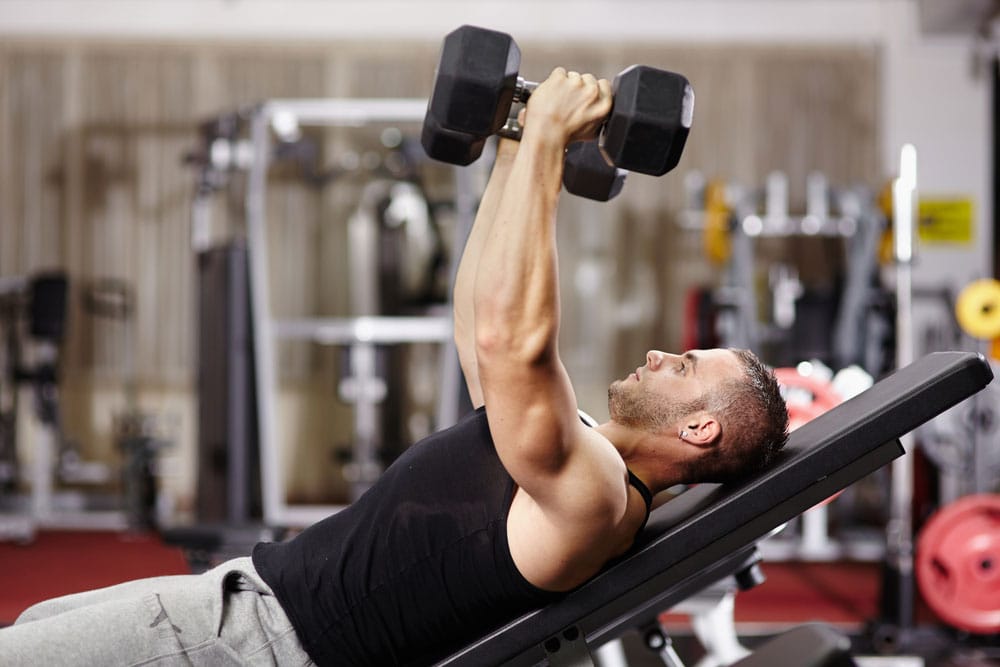
- Set-Up: Set up a weight bench to a 30-45 degree incline and lie back holding one dumbbell in each hand. Your head and chest should sit above your hips. Use a medium to heavy weight here.
- Lift: Press the dumbbells straight up until your arms are fully extended.
- Reverse: Lower them back down until your elbows come to 90 degrees.
- Reps: Aim for 3 sets of 10-12 reps.
4. Decline Dumbbell Press
- Set-Up: Adjust a bench to a 30-45 degree decline and lie back with a dumbbell in each hand. Your head and chest should sit below your hips. This can feel a bit awkward and take some getting used to. Use medium to heavy dumbbells.
- Lift: Press the dumbbells straight up until your arms are fully extended.
- Reverse: Lower them back down until your elbows come to 90 degrees.
- Reps: Aim for 3 sets of 10-12 reps.
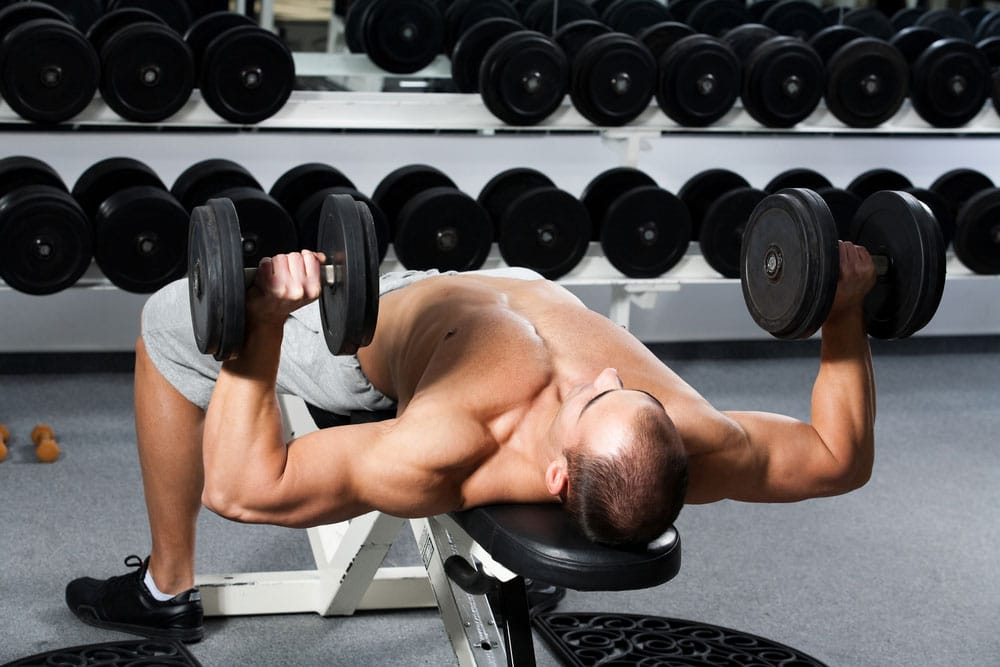
5. Dumbbell Pullover
- Set-Up: Lie down at a perpendicular angle with your weight bench with just your upper back and shoulders supported (Think about making a T-shape with the bench and your body). Grab one dumbbell and hold it with both hands overhead.
- Pull-Over: Lower the dumbbell behind your head, keeping a slight bend in your elbows until you feel a stretch in your chest and lats (the big muscles in your back).
- Reverse: From here, bring the dumbbell back up to the starting position.
- Reps: Try 2-3 sets of 12-15 reps.
6. Dumbbell Push-Up
This move is equipment-dependent since you can only do it using hexagonal dumbbells. Dumbbell push-ups extend your range of motion compared to a regular push-up.
Here, you can really get deep into your movement to feel the muscles of your chest at work.
- Set-Up: Grab two hexagonal dumbbells and line them up with your shoulders, balancing them on their flat edges. Come to a high plank position like you would for a regular push-up and grip the handles of your dumbbells.
- Push-Up:
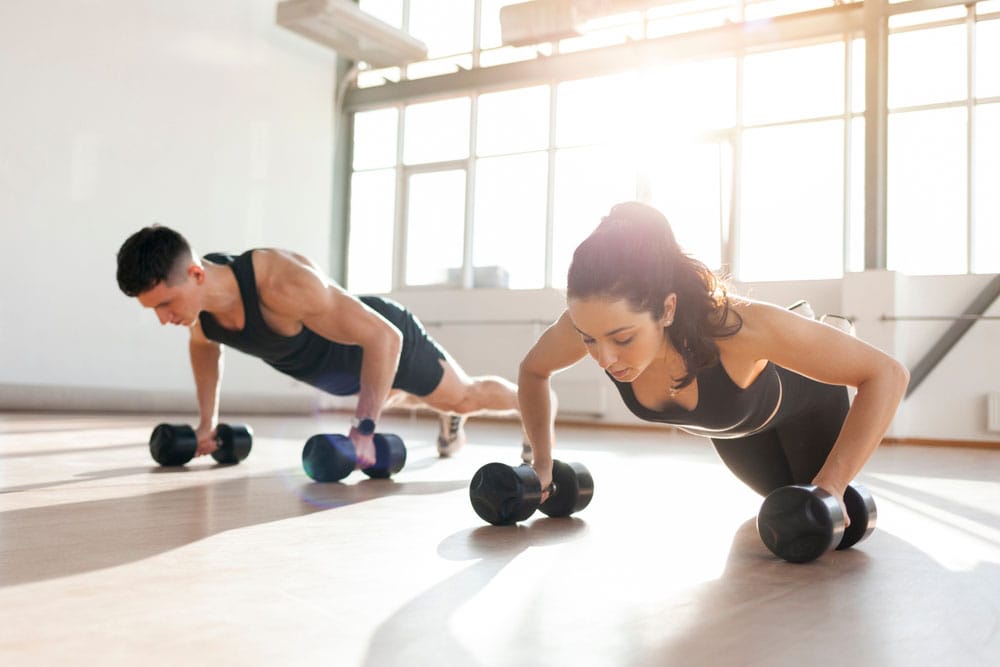
Incorporating a variety of dumbbell chest exercises into your routine can help build strength, muscle mass, and definition in your chest muscles. Remember to use proper form and gradually increase weight as you progress to maximize results and minimize the risk of injury.
How Often Should You Train Your Chest?
This will depend on a few factors like overall fitness goals, training experience, and your time allotment for exercise.
A general guideline for most people is to train the chest around twice per week. This can vary a lot based on different training goals.
Muscle Growth (Hypertrophy)
If you want to increase the size of your muscles and work toward definition in your chest, twice a week is your best bet.
Splitting chest workouts into a few separate sessions lets you get in higher rep volume and more targeted muscle stimulation, which can help stimulate the muscles to grow.
Strength
If you’re mostly looking to get stronger in your chest and hit metrics like getting a bigger bench press, training the chest muscles even once a week with HEAVY weights and a low to moderate rep range (e.g., 4-6 reps) can work.
Always focus on progressive overload, increasing your weight each time you lift to keep challenging your muscles and stimulating strength gains.
To learn more about getting a stronger chest for bench pressing, here are some resources:
- How to Bench More
- Push-Ups vs. Bench Press
- Best Incline Bench Angle
- Dumbbell vs. Barbell Bench Press
Endurance
For endurance-focused training or basically to keep in shape, you’ll need to focus on training more reps per set to break into your cardio zone.
Training your chest muscles once a week with moderate to high repetitions of lighter weight (10-15 reps or so) can help you get better muscular endurance and improve your heart health.
Why Won’t My Chest Grow?
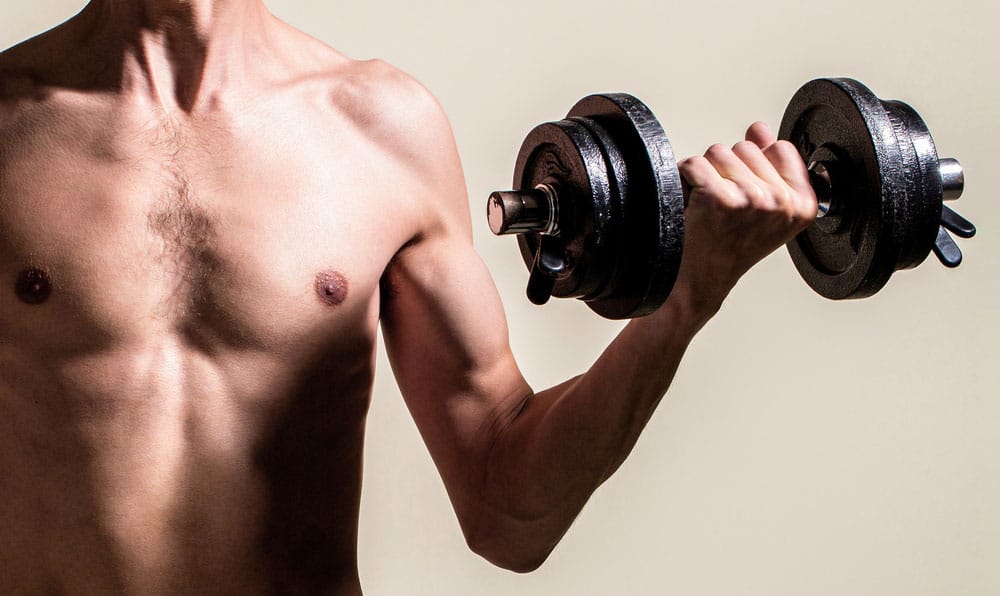
There are several factors that go into getting a big chest or even seeing any kind of growth at all.
You’re Not Training Enough
To see real benefits in your chest muscles in order to get more size, you need to maintain a consistent training schedule.
Generally, it’s good to hit each major muscle group that you want to grow around 2-3 times a week. This includes your chest.
Genetics
Some of us have narrow clavicles. Some struggle with bad bicep genetics or bad shoulder genetics.
And a few of us are just unfortunately born to be bird-chested. Not everyone has the ideal genes to build the chest of a Greek God.
In fact, some people don’t build muscle quite as easily as others at all. There’s a gene called ACTN3 that is being researched as a major component of skeletal muscle control. It is thought to be prevalent or especially active among elite athletes.
You can read more about it here: Genetic Aspects of Skeletal Muscle Strength.
But even if you’re not genetically blessed, you can still work with what you’ve got.
You’re Not Switching Things Up
If your chest days consist of a lot of “samesy” moves (bench press, push-up, etc.) you may not be seeing quick results.
Although these moves are fantastic staples and you should absolutely keep them in your training program, repeating the same moves (albeit at heavier weights, hopefully!) only stimulates the muscle in one way.
For men, a common frustration area is the upper chest. “Why won’t my upper chest grow?” you may be wondering, as you crank out 100 push-ups a day.
The answer is that although you’re training it, you may not be attacking the muscles in various ways so that they’re stimulated to grow. Try training incline chest moves if you’re struggling with a small upper chest and declines if you want to fill out your lower pecs.
Chest Training Tips
Take Recovery
It’s okay (and necessary) to take a break sometimes.
Getting proper rest and recovery are key for muscle growth and overall performance. Let yourself get at least 48 hours of rest between chest workouts so your muscles can recover and repair.
Overtraining your chest muscles without enough recovery can lead to fatigue, decreased performance, and heightened injury risk.
Balance Your Training
It’s important to keep a balance in your workout routine by training all your major muscle groups. This includes the chest, but also the shoulders, back, legs, and arms.
Getting in a well-rounded training program that targets different muscle groups throughout the week can help you prevent muscular imbalances. It’s also a good way to reduce your risk of overuse injuries to any one muscle group.
Ultimately, the frequency of chest training is up to you. It will depend on your own preferences and recovery capacity. Always check in with your body and adjust your training accordingly.
Don’t be afraid to drop moves that you aren’t enjoying or seeing good results from in favor of one’s you actually enjoy doing.
The Takeaway
Training your chest with dumbbells is one of the quickest and most effective ways to see it grow.
Workouts like bench presses, incline and decline work and push-ups with dumbbells are all fantastic and easy ways to execute chest workouts with dumbbells.
These moves are all fairly simple to incorporate into your training routine. Aim to train your chest between 1-3 days a week and you should be able to see results over time.
Everyone’s chest is different and you may be blessed or not so much in the genetics department. That being said, training your chest can help pretty much anyone make some degree of progress.
Always remember to rest up and stretch after your chest days. That way, you can build a balanced body that looks and feels the way you want it to.
References
Aicale, R., Tarantino, D., & Maffulli, N. (2018). Overuse injuries in sport: a comprehensive overview. Journal of orthopaedic surgery and research, 13(1), 309. https://doi.org/10.1186/s13018-018-1017-5
Krzysztofik, M., Wilk, M., Wojdała, G., & Gołaś, A. (2019). Maximizing Muscle Hypertrophy: A Systematic Review of Advanced Resistance Training Techniques and Methods. International journal of environmental research and public health, 16(24), 4897. https://doi.org/10.3390/ijerph16244897
Roth S. M. (2012). Genetic aspects of skeletal muscle strength and mass with relevance to sarcopenia. BoneKEy reports, 1, 58. https://doi.org/10.1038/bonekey.2012.58
Related articles


Get fit with Flex
Build muscle & lose weight fast for free.
Available on iPhone + Apple Watch
